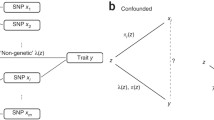Abstract
Statistical methods aimed at the detection of genes for quantitative traits suffer from two problems: (i) when a linkage approach is employed, relatively large sample sizes are usually required; and (ii) when an association approach is employed, effects of population stratification may blur genuine locus–trait associations. The variance components method proposed by Fulker et al. (1999) addressed both these problems; it is statistically powerful because it involves a combined analysis of linkage and association and can include information from multiplex families, which reduces the overall amount of necessary individual genotypes. In addition, it includes an explicit test for the presence of spurious association. After a brief illustration of the various ways in which population stratification may affect locus–trait associations, the implementation in Mx (Neale, 1997) of the method as proposed by Fulker et al. (1999) is discussed and illustrated. In addition, an extension to this method is proposed that allows the use of (variable) sibship sizes greater than two, the estimation of additive and dominance association effects, and the use of multiple alleles. These extensions can be implemented when parental genotypes are available or unavailable.
Similar content being viewed by others
Author information
Authors and Affiliations
Rights and permissions
About this article
Cite this article
Posthuma, D., de Geus, E.J.C., Boomsma, D.I. et al. Combined Linkage and Association Tests in Mx. Behav Genet 34, 179–196 (2004). https://doi.org/10.1023/B:BEGE.0000013732.19486.74
Issue Date:
DOI: https://doi.org/10.1023/B:BEGE.0000013732.19486.74




